Babies need a safe and comfortable place to sleep in the first few years of their life. New parents must choose between a crib, cradle, or bassinet based on their needs and preferences. These baby beds differ in their design, features, and benefits. As a baby furniture retailer, you must know these differences to optimize your customers’ selection. Now, let’s look deeper at comparing crib vs cradle vs bassinet.
Here's a comparison table between a crib, a cradle, and a bassinet:
|
Feature
|
Crib
|
Cradle
|
Bassinet
|
|
Size |
Larger and more spacious |
Smaller and more compact |
Smaller and more compact |
|
Purpose |
Long-term use for infants and toddlers |
Short-term use for newborns |
Short-term use for newborns |
|
Design |
Stationary or convertible models available |
Typically has a rocking or swinging motion |
Some is portable and can have a rocking motion |
|
Mobility |
Generally not easily movable |
Not designed for mobility |
Highly portable and lightweight |
|
Safety |
Generally more safety features |
Moderate safety features |
Adequate safety features |
|
Longevity |
Can be used for several years |
Typically used for a few months |
Used for the first few months |
|
Storage |
May have storage drawers or shelves |
Limited to no storage options |
Some have storage options |
|
Cost |
Moderate to higher cost |
Moderate cost |
Lower to moderate cost |
|
Assembly |
May require more complex assembly |
Usually simple assembly |
Usually simple assembly |
|
Convenience |
May require bending to access the baby |
Easy access due to its height |
Easy access due to its height |
|
Recommended Age |
Toddler stage onwards |
Newborn to a few months old |
Newborn to a few months old |
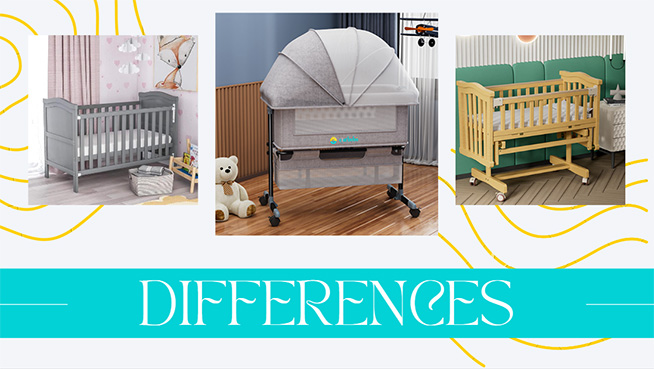
The differences between the 3 types of baby furniture are divided into 3 terms: size and portability; purpose and recommended usage; safety features and guidelines.
● Crib: A crib is a larger freestanding bed for infants and toddlers. Cribs are more permanent and stationary, not very portable. Cribs typically have rigid sides for safety and security. They come in various sizes, from small cribs to large ones that accommodate toddlers.
● Cradle: A cradle is a smaller bed, typically intended for infants. Cradles are more compact and portable than cribs. They have lower sides than cribs, so they are easier to access. Cradles are very mobile, and some even have wheels for easy movement.
● Bassinet: A bassinet is the smallest of the three and is intended for newborns. Bassinets are very lightweight, compact, and portable. They are often made of mesh or have padded sides for airflow and visibility. Bassinets can be moved from room to room and folded or collapsed for storage.
● Crib: A crib is designed for infants and toddlers up to about 3 years of age. Cribs provide a safe sleeping space and are ideal for overnight sleeping. Cribs are recommended for all stages of infancy and toddlerhood.
● Cradle: A cradle is primarily used for infants up to about 6-12 months of age. Cradles are suitable for shorter naps and monitoring infants. They are easier to access than cribs but may not be as safe for overnight sleeping. They are best suited for infancy.
● Bassinet: A bassinet is intended for newborns up to about 4 months of age. Bassinets provide a cozy and breathable sleeping space close to parents. They are ideal for monitored naps and overnight sleeping for infants. Bassinets are recommended until the baby outgrows them, usually around 4 months.
● Crib: Cribs are designed to be safe sleeping spaces for infants and toddlers. They meet strict safety standards for slat spacing, rail height, drop-side mechanisms, and stability. Cribs are considered the safest option for overnight sleeping.
● Cradle: Cradles typically have less rigid safety features than cribs. Cradles are not considered an entirely safe space for unsupervised sleeping. Cradles are best used when there is close parental supervision.
● Bassinet: Bassinets usually have mesh netting or padded mesh sides instead of rigid slats. They may have little to no railings. While they are very lightweight and portable, they do not meet the same safety standards as cribs.
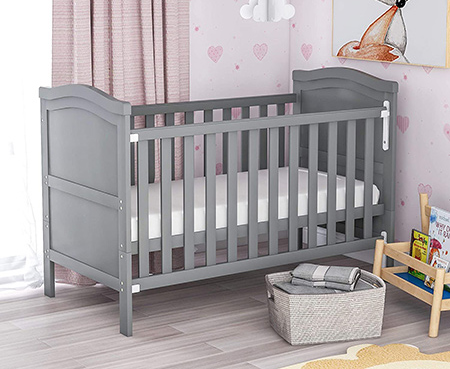
Cribs are enclosed baby beds with high sides and slats that provide safety, security, and containment for infants while allowing for comfortable sleeping. While cribs typically have a shorter lifespan and lower resale value, they offer an affordable, safe sleeping space for new babies with minimal maintenance costs—a featured benefit for busy new parents on a budget.
Common types of cribs:
● Standard crib: A basic rectangular crib frame with high enclosed sides is typically considered the default type. It provides a safe sleeping space for babies up to 3 years old but does not convert into any other bed frame. Standard cribs tend to be the most affordable but have the shortest lifespan.
● Convertible crib: A convertible crib can become a toddler bed, daybed, or full-size bed as a child grows out of the crib. It has several conversion kits included or available to extend its use. Convertible cribs tend to last longer but have a higher upfront cost.
● Portable crib: A portable crib is designed to be easy to assemble, disassemble and move from place to place. Frames fold open and collapse for storage and often have wheels for transporting. Portable cribs provide flexibility but are not as durable or last as long as standard cribs. They require more manual labor to set up and take down.
Cribs sold in the US must meet strict safety standards set by the Consumer Product Safety Commission (CPSC). These standards aim to prevent injuries and ensure the safety of infants sleeping in cribs.
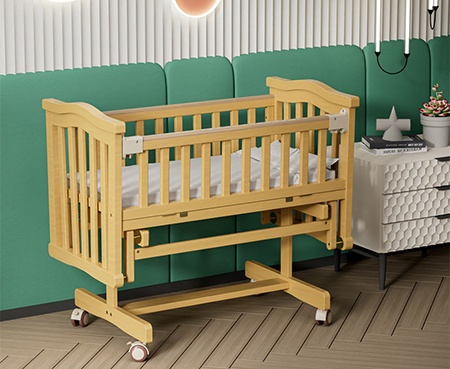
A cradle is an open bed frame with low or no sides for young infants. Typically used for babies under 6-12 months, a cradle has short, decorative, or open sides for visibility and airflow. A cradle provides less containment and security than a crib.
Common types of cradle:
● Rocking cradle: A rocking cradle has a floor-based swinging mechanism that allows the cradle to rock back and forth gently. Pushing on the floor or tilting the cradle frames starts and stops the rocking motion.
● Swinging cradle: A swinging cradle suspends from ceiling beams or other overhead structures, allowing the cradle to swing freely. A push or pull starts the swinging motion.
When choosing a cradle for your kids or retail stores, consider some safety factors below:
● Low or open sides.
● Secure mounting (for rocking cradles).
● Appropriate for age and development.
● No loose or missing parts.
● Proper mattress fit.
● No bumpers, loose bedding or toys.
● Always place to sleep on back.
● Adult supervision.
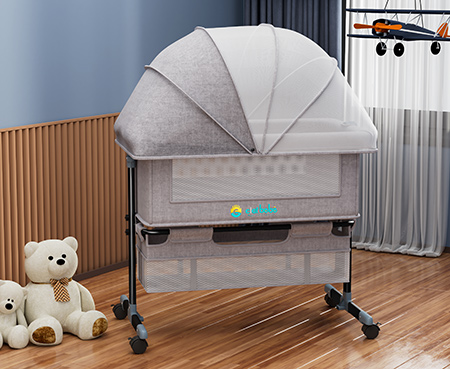
A bassinet is an extra small baby bed with shallow sides or no sides. Bassinets are designed for newborns and provide an open sleeping space close to parents. They have little or no frame sides, allowing maximum visibility, airflow, and proximity to caregivers. Bassinets offer convenience, visibility, and cooling benefits ideal for newborns, as they cannot regulate their body temperature.
Common types of cradle:
● Bedside bassinet: A bedside bassinet attaches to the side of a parent's bed, allowing a baby to sleep within arm's reach at night. It has high sides for safety but cannot stand alone.
● Portable bassinet: A portable bassinet can stand alone but is designed to be collapsible for easy transportation and storage. Its lightweight, compact frame can be set up wherever needed.
Bassinets sold in the US must meet safety standards set by the Consumer Product Safety Commission (CPSC) to ensure the safety of infants. CPSC is an independent US government agency responsible for protecting the public from unsafe consumer products.
There are many options for baby cribs, cradles, and baby bassinet that you can refer to as a parent or a baby furniture retailer:
Eco-friendly Solid Wood Newborn Baby Crib With Storage
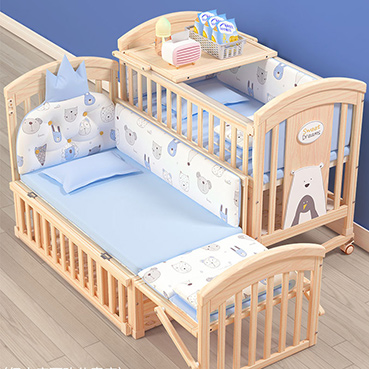
This solid pine wood crib has a smooth and lacquered finish, free of burrs and is tasteless. It can be attached to a large bed and has a lengthening head. The large storage layer provides quick and convenient access to daily supplies. The versatile crib can be converted to a toddler or sofa bed for independent play. It features three height adjustments, a flip storage board for easy diaper changes, and shaker feet with reinforced caps to protect floors. The 10° rocking coax bed helps babies sleep comfortably.
Newborn Baby Cradle With Cute Bear Design
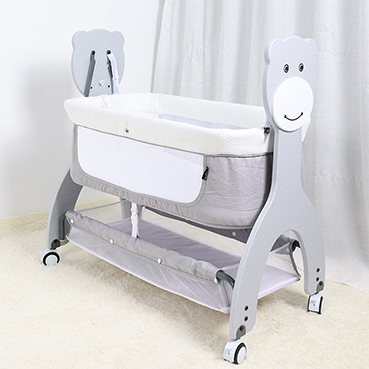
Made from breathable LVL and cotton, this mobile baby cradle also has a convenient storage function. With rounded corners, it minimizes the risk of scratches and injuries. The cradle can also be attached to a large bed, allowing easy night feedings. It also has four wheels, making moving from room to room simple.
Portable Wooden Baby Bassinet With Canopy
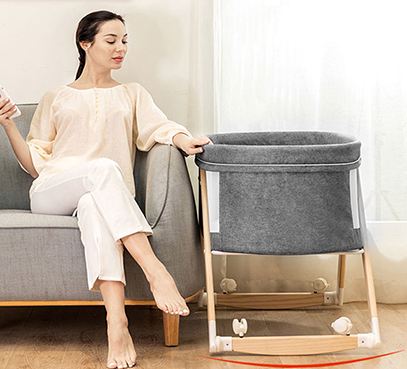
This popular wooden bedside bassinet for babies aged 0-3 is made from eco-friendly New Zealand Pine Wood and Linen Cotton. It features breathable netting on two sides for optimal airflow and comfort. The bassinet can easily adjust between push mode and cradle bed with brakes on the casters. With a weight capacity of 80 kg, it comes with a full-cover mosquito net that is shaded and breathable. Its tiltable design makes feeding easy and helps prevent vomiting. It can also be used as a cradle bed or game bed. Accessories include a mosquito net, pole, universal wheel, and anti-gnawing strip.
Hefei Craft Child Product Co., Ltd. is a reliable and reputable company for businesses looking to wholesale baby cribs, cradles, and bassinets. They offer high-quality products made from eco-friendly materials like New Zealand Pine Wood and Linen Cotton. Their products come with multiple features. The company is known for its exceptional customer service, competitive pricing, and timely delivery. Additionally, Craftbebe allows retailers to customize baby cribs, cradles, and bassinets based on their branding.
In conclusion, cribs, cradles, and bassinets have benefits and suit different stages of infant development. Still, they differ significantly in size, portability, purpose, safety features, and recommended usage. Contact us at https://www.craftchildren.com/ for expert recommendations on cribs, cradles, bassinets, or other baby essentials. We offer guidance and suggestions to ensure you choose high-quality, safe, and durable products that will give you peace of mind for your little one.
Related Posts
Top Baby Furniture Manufacturers - The Ultimate Guide
Best Baby Crib Manufacturers in UAE
Best Baby Cribs in 2024: A Complete Guide
Cribs vs Bassinets vs Cradles - Which Is Right for Your Baby?
Mini Crib vs. Bassinet(Meaning, differences, pros and cons)
Crib vs Cradle vs Bassinet (Meaning, Differences, Features, Benefits)